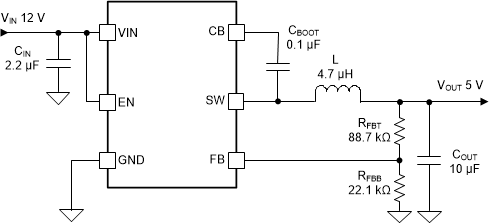SLUSDW3A April 2020 – November 2020 LMR50410
PRODUCTION DATA
- 1 Features
- 2 Applications
- 3 Description
- 4 Revision History
- 5 Device Comparison Table
- 6 Pin Configuration and Functions
- 7 Specifications
- 8 Detailed Description
- 9 Application and Implementation
- 10Power Supply Recommendations
- 11Layout
- 12Device and Documentation Support
- 13Mechanical, Packaging, and Orderable Information
Package Options
Mechanical Data (Package|Pins)
- DBV|6
Thermal pad, mechanical data (Package|Pins)
Orderable Information
9.2 Typical Application
The LMR50410 only requires a few external components to convert from a wide voltage range supply to a fixed output voltage. Figure 9-1 shows a basic schematic.
 Figure 9-1 Application Circuit
Figure 9-1 Application CircuitThe external components have to fulfill the needs of the application and the stability criteria of the control loop of the device. Table 9-1 can be used to simplify the output filter component selection.
Table 9-1 L and COUT Typical Values
| fSW (kHz) | VOUT (V) | L (µH) | COUT (µF) (1) | RFBT (kΩ) | RFBB (kΩ) |
|---|---|---|---|---|---|
| 700 | 3.3 | 10 | 22 µF / 10 V | 51 | 22.1 |
| 5 | 15 | 22 µF / 10 V | 88.7 | 22.1 | |
| 12 | 33 | 22 µF / 25 V + 10 µF / 25 V | 243 | 22.1 |
(1) A ceramic capacitor is used in
this table.